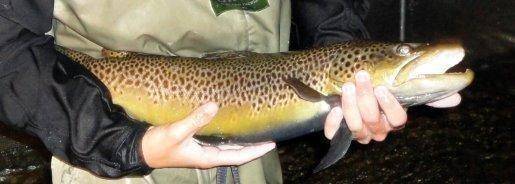You don’t need to cancel your plans to fish one of the country’s best trout waters this summer.
The Green River in Utah is running higher than normal. But those who have learned how to fish during higher flows are enjoying good to excellent fishing.
“Rumors are flying,” says Ron Stewart, “but the fact remains: everything that makes [the river] an internationally known blue-ribbon trout fishery — the fish, the scenery … well, everything — is still
there.”
Stewart serves as a conservation outreach manager for the Utah Division Wildlife Resources. He shares something long-time anglers already know: the fish in the Green River will adapt to the changing conditions. “But,” Stewart says, “based on the rumors and number of trips being canceled, it sounds like the fish are adapting faster than the anglers.”
Located in northeastern Utah, the first eight miles of the river hold about 120,000 trout. The high number of gorgeous fish — and the breathtaking scenery — make the stretch of the river below Flaming Gorge dam one of the best trout fishing waters in the nation.
You can stay updated on fishing conditions on the river by reading the DWR’s weekly fishing report. The report is available at www.wildlife.utah.gov/hotspots.
Higher flows can improve fishing
Stewart says higher flows — especially flushing flows designed to help endangered fish in the river — move vegetation in the river. Those flows knock insects and other invertebrates off the vegetation and into the water. The trout in the river often go into a feeding frenzy after the insects and invertebrates have entered the water.
Stewart says as long as the flows have a chance to stabilize, the fish will adjust to the new flows and start feeding again in a few hours.
To help reduce flooding downstream, reports from the dam indicate the water flows will stay stable at about 4,500 cubic feet per second(cfs) while the Yampa River remains high.
The stable flows should lead to good to excellent fishing this summer.
Try these techniques
To catch trout in the river this summer, Stewart suggests the following:
- Look for slower moving water. “When the flows increase,” Stewart says, “the Green River just gets deeper and a bit faster because the canyon restricts the shape of the river.” Fish adjust to the faster flows by moving to areas that have rocks that slow the flow of the water. Cobble-sized rocks give fish shelter close to the bottom. Big rocks and rock reefs create small to large eddies that fish often “stack up” in to avoid the rushing water. Both of these places are great places to look for fish.
- To compensate for a deeper river, fish deeper. Use a selection of flies and lures that will reach down into the deeper water. Streamers, and deep-diving lures or jigs, are good choices. “If you’ve fished the river in late fall or winter,” Stewart says, “you should already have what you need as winter techniques generally [require fishing] along the bottom.” Stewart suggests attaching a scud or shrimp imitation behind a streamer. This is a deadly combination when fishing in deep water. The streamer does three things: 1. It’s heavier, so it fishes deeper in the water column 2. It offers trout a tempting morsel 3. It acts as an attractor that draws fish. Trout often hit the trailing scud after being drawn to the streamer.
- Stewart says other anglers are doing well deep drifting nymphs, minnow or egg imitations, letting these large terrestrials sink to the bottom. The reason this technique works is simple: as mentioned earlier, when the river rises, the vegetation floods. As the vegetation floods, grasshoppers, crickets, ants, caterpillars and cicadas are forced into the water. Stewart says you can fish these offerings on top of the water, but letting them sink should bring you more fish.
- Also, remember to watch for hatches. “Insect life doesn’t stop just because someone is letting more water out of the dam,” Stewart says. “As the water warms, it will trigger more hatches.”
Trails
Stewart says you don’t need to be concerned about finding trails that will give you access to the river. The current river flow rate is only 4,500 cfs. “The trails are just fine,” Stewart says.
The trails do flood in some areas when water is released through the dam’s bypass tubes and water flows shoot up to 9,000 cfs. However, even if the dam releases its higher flows, Stewart says there is still a fishable bank — with some great fishing — in the Little Hole area.
“The Green is still the Green,” Stewart says. “Rather than canceling your trip and missing [some] excellent fishing, maybe you should [plan on staying] an extra day.”

